Organizational Behavior Analysis: How to Lose a Guy in Ten Days
VerifiedAdded on 2022/08/23
|8
|2477
|12
Report
AI Summary
This report offers a detailed analysis of the film 'How to Lose a Guy in Ten Days' through an organizational behavior (OB) lens. The analysis is divided into two parts: a reflective section exploring personal observations and character integrity, and a critical section focusing on the application of decision-making school and open-system theory to the characters' behaviors. The reflective part examines the motivations and actions of the main characters, Ben and Andie, and their interactions, including the roles of supporting characters. The critical part connects the characters' actions to OB theories, particularly decision-making within an organizational context and the open-system theory's relevance to the characters' interconnectedness and goal-oriented behavior. The report highlights the themes of competition, ethics, and the impact of individual decisions on relationships within the framework of the film's narrative. The analysis concludes with a synthesis of the theories and their application to the characters' actions and the overall plot of the movie.
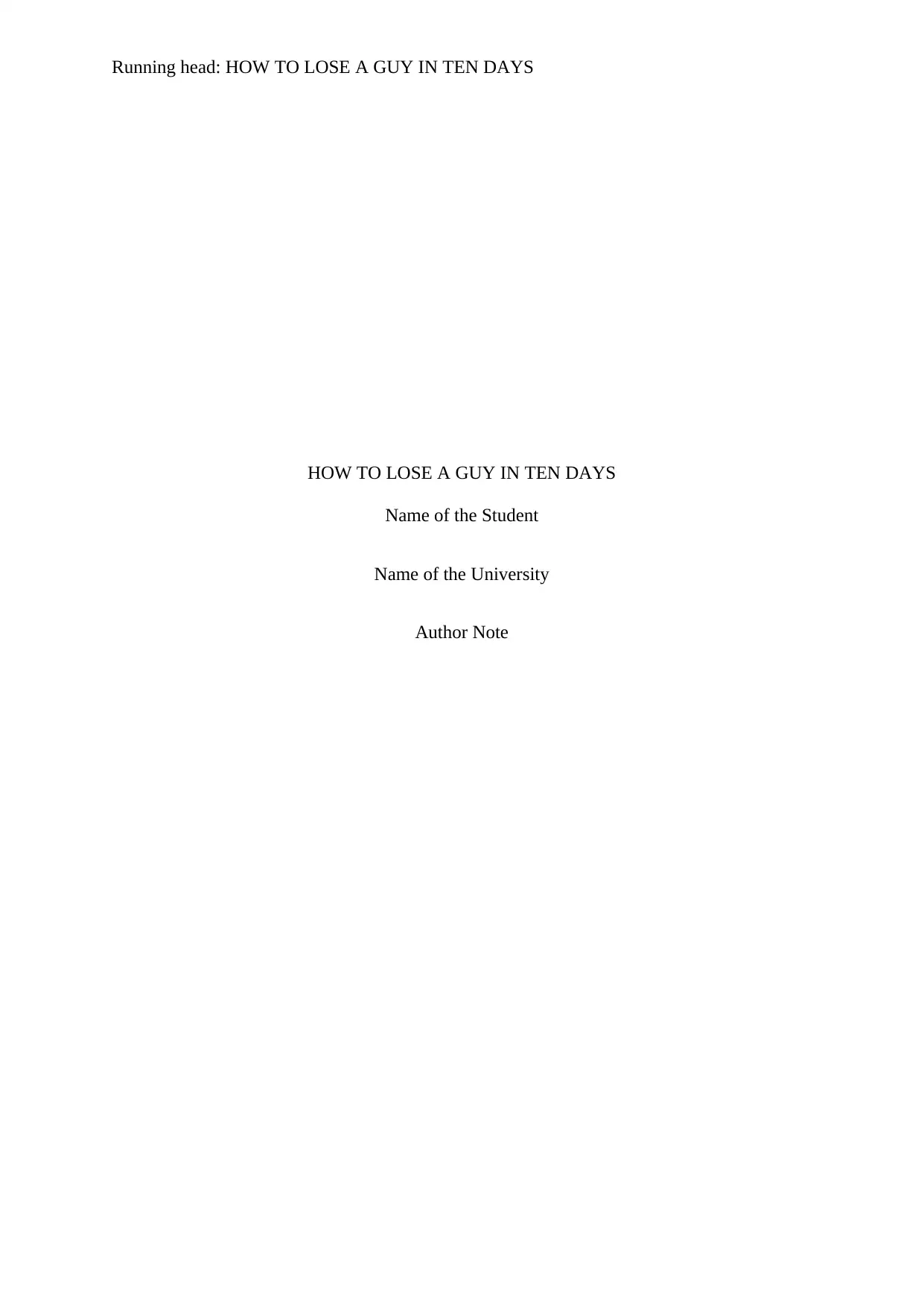
Running head: HOW TO LOSE A GUY IN TEN DAYS
HOW TO LOSE A GUY IN TEN DAYS
Name of the Student
Name of the University
Author Note
HOW TO LOSE A GUY IN TEN DAYS
Name of the Student
Name of the University
Author Note
Paraphrase This Document
Need a fresh take? Get an instant paraphrase of this document with our AI Paraphraser
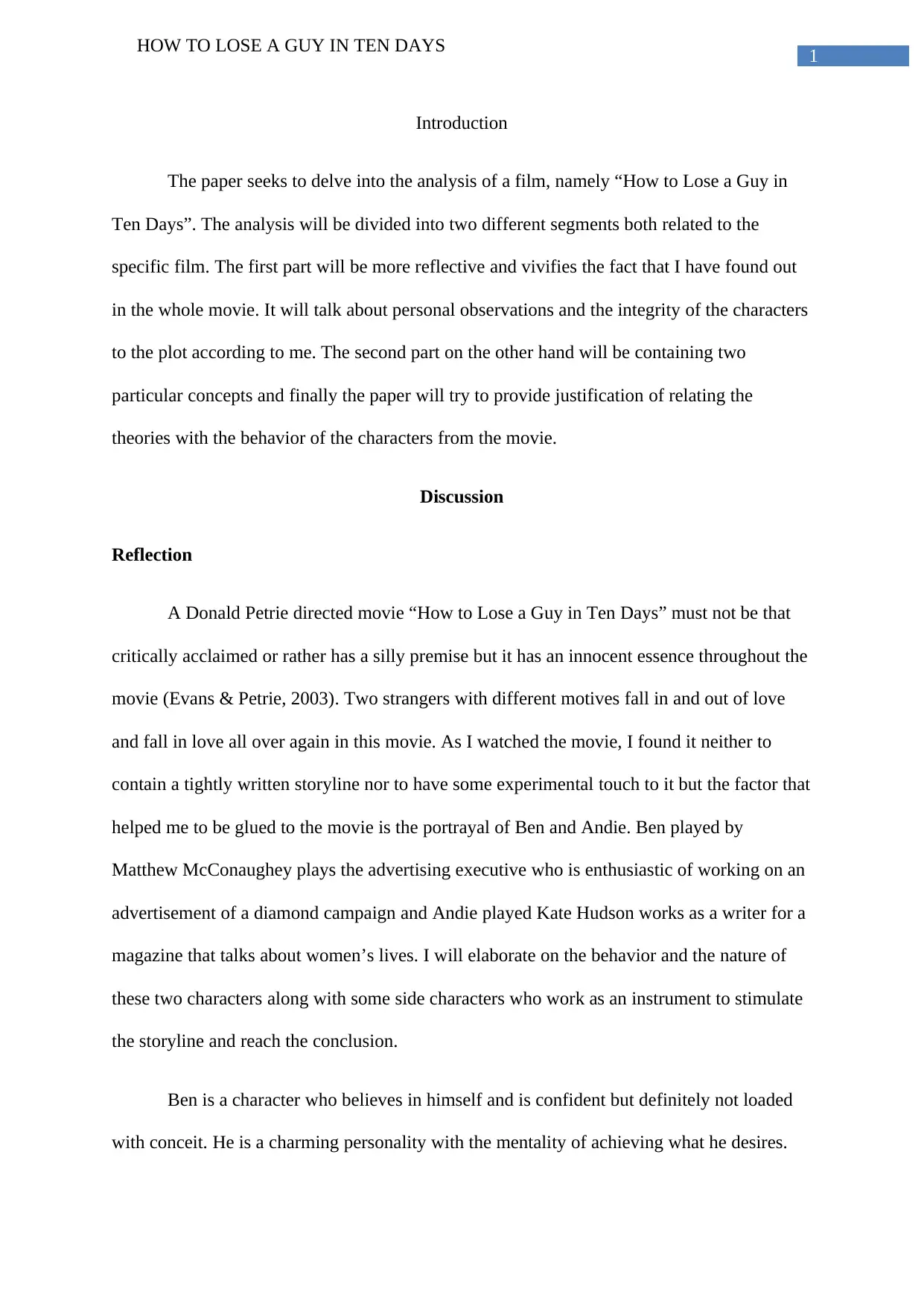
1
HOW TO LOSE A GUY IN TEN DAYS
Introduction
The paper seeks to delve into the analysis of a film, namely “How to Lose a Guy in
Ten Days”. The analysis will be divided into two different segments both related to the
specific film. The first part will be more reflective and vivifies the fact that I have found out
in the whole movie. It will talk about personal observations and the integrity of the characters
to the plot according to me. The second part on the other hand will be containing two
particular concepts and finally the paper will try to provide justification of relating the
theories with the behavior of the characters from the movie.
Discussion
Reflection
A Donald Petrie directed movie “How to Lose a Guy in Ten Days” must not be that
critically acclaimed or rather has a silly premise but it has an innocent essence throughout the
movie (Evans & Petrie, 2003). Two strangers with different motives fall in and out of love
and fall in love all over again in this movie. As I watched the movie, I found it neither to
contain a tightly written storyline nor to have some experimental touch to it but the factor that
helped me to be glued to the movie is the portrayal of Ben and Andie. Ben played by
Matthew McConaughey plays the advertising executive who is enthusiastic of working on an
advertisement of a diamond campaign and Andie played Kate Hudson works as a writer for a
magazine that talks about women’s lives. I will elaborate on the behavior and the nature of
these two characters along with some side characters who work as an instrument to stimulate
the storyline and reach the conclusion.
Ben is a character who believes in himself and is confident but definitely not loaded
with conceit. He is a charming personality with the mentality of achieving what he desires.
HOW TO LOSE A GUY IN TEN DAYS
Introduction
The paper seeks to delve into the analysis of a film, namely “How to Lose a Guy in
Ten Days”. The analysis will be divided into two different segments both related to the
specific film. The first part will be more reflective and vivifies the fact that I have found out
in the whole movie. It will talk about personal observations and the integrity of the characters
to the plot according to me. The second part on the other hand will be containing two
particular concepts and finally the paper will try to provide justification of relating the
theories with the behavior of the characters from the movie.
Discussion
Reflection
A Donald Petrie directed movie “How to Lose a Guy in Ten Days” must not be that
critically acclaimed or rather has a silly premise but it has an innocent essence throughout the
movie (Evans & Petrie, 2003). Two strangers with different motives fall in and out of love
and fall in love all over again in this movie. As I watched the movie, I found it neither to
contain a tightly written storyline nor to have some experimental touch to it but the factor that
helped me to be glued to the movie is the portrayal of Ben and Andie. Ben played by
Matthew McConaughey plays the advertising executive who is enthusiastic of working on an
advertisement of a diamond campaign and Andie played Kate Hudson works as a writer for a
magazine that talks about women’s lives. I will elaborate on the behavior and the nature of
these two characters along with some side characters who work as an instrument to stimulate
the storyline and reach the conclusion.
Ben is a character who believes in himself and is confident but definitely not loaded
with conceit. He is a charming personality with the mentality of achieving what he desires.
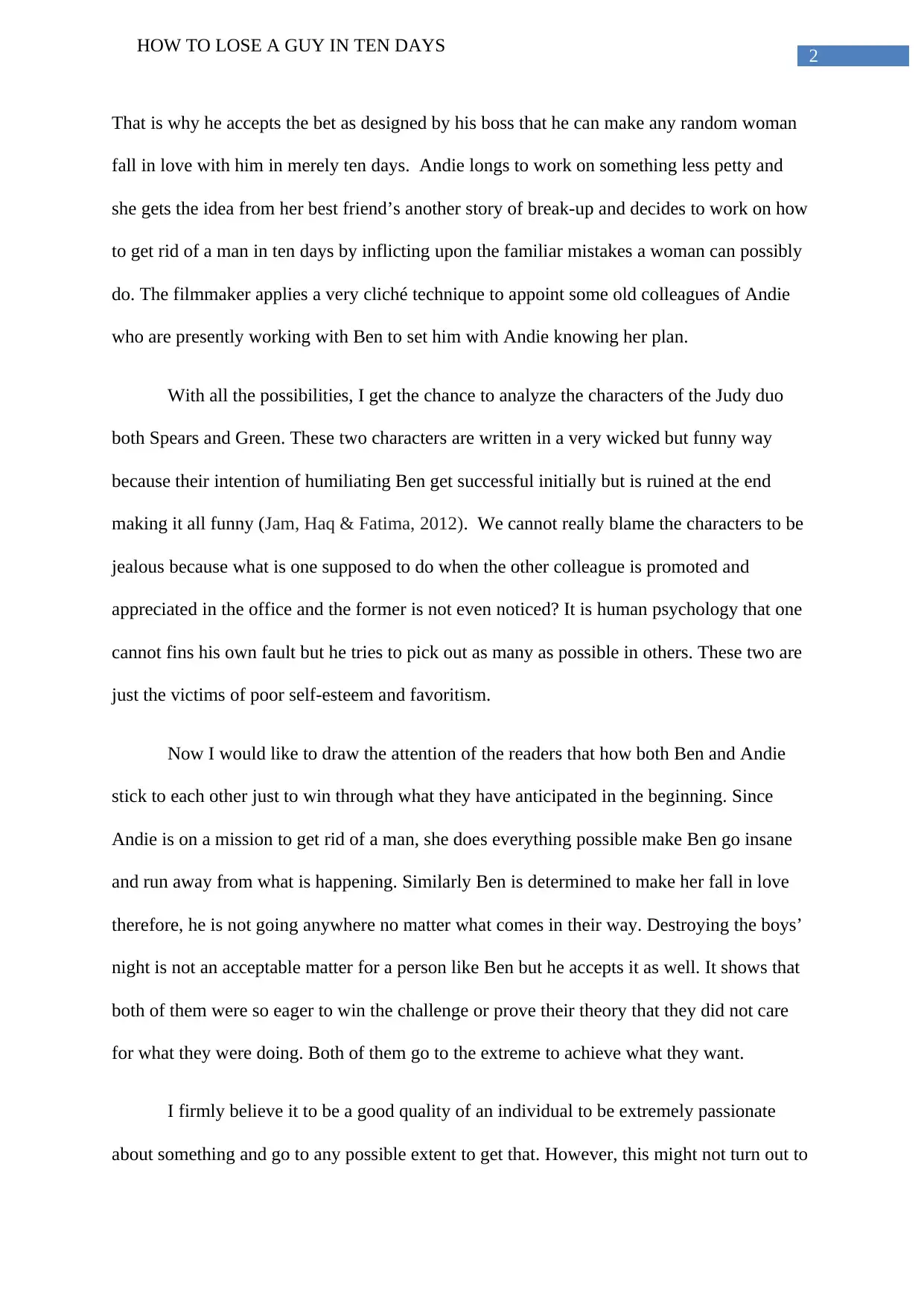
2
HOW TO LOSE A GUY IN TEN DAYS
That is why he accepts the bet as designed by his boss that he can make any random woman
fall in love with him in merely ten days. Andie longs to work on something less petty and
she gets the idea from her best friend’s another story of break-up and decides to work on how
to get rid of a man in ten days by inflicting upon the familiar mistakes a woman can possibly
do. The filmmaker applies a very cliché technique to appoint some old colleagues of Andie
who are presently working with Ben to set him with Andie knowing her plan.
With all the possibilities, I get the chance to analyze the characters of the Judy duo
both Spears and Green. These two characters are written in a very wicked but funny way
because their intention of humiliating Ben get successful initially but is ruined at the end
making it all funny (Jam, Haq & Fatima, 2012). We cannot really blame the characters to be
jealous because what is one supposed to do when the other colleague is promoted and
appreciated in the office and the former is not even noticed? It is human psychology that one
cannot fins his own fault but he tries to pick out as many as possible in others. These two are
just the victims of poor self-esteem and favoritism.
Now I would like to draw the attention of the readers that how both Ben and Andie
stick to each other just to win through what they have anticipated in the beginning. Since
Andie is on a mission to get rid of a man, she does everything possible make Ben go insane
and run away from what is happening. Similarly Ben is determined to make her fall in love
therefore, he is not going anywhere no matter what comes in their way. Destroying the boys’
night is not an acceptable matter for a person like Ben but he accepts it as well. It shows that
both of them were so eager to win the challenge or prove their theory that they did not care
for what they were doing. Both of them go to the extreme to achieve what they want.
I firmly believe it to be a good quality of an individual to be extremely passionate
about something and go to any possible extent to get that. However, this might not turn out to
HOW TO LOSE A GUY IN TEN DAYS
That is why he accepts the bet as designed by his boss that he can make any random woman
fall in love with him in merely ten days. Andie longs to work on something less petty and
she gets the idea from her best friend’s another story of break-up and decides to work on how
to get rid of a man in ten days by inflicting upon the familiar mistakes a woman can possibly
do. The filmmaker applies a very cliché technique to appoint some old colleagues of Andie
who are presently working with Ben to set him with Andie knowing her plan.
With all the possibilities, I get the chance to analyze the characters of the Judy duo
both Spears and Green. These two characters are written in a very wicked but funny way
because their intention of humiliating Ben get successful initially but is ruined at the end
making it all funny (Jam, Haq & Fatima, 2012). We cannot really blame the characters to be
jealous because what is one supposed to do when the other colleague is promoted and
appreciated in the office and the former is not even noticed? It is human psychology that one
cannot fins his own fault but he tries to pick out as many as possible in others. These two are
just the victims of poor self-esteem and favoritism.
Now I would like to draw the attention of the readers that how both Ben and Andie
stick to each other just to win through what they have anticipated in the beginning. Since
Andie is on a mission to get rid of a man, she does everything possible make Ben go insane
and run away from what is happening. Similarly Ben is determined to make her fall in love
therefore, he is not going anywhere no matter what comes in their way. Destroying the boys’
night is not an acceptable matter for a person like Ben but he accepts it as well. It shows that
both of them were so eager to win the challenge or prove their theory that they did not care
for what they were doing. Both of them go to the extreme to achieve what they want.
I firmly believe it to be a good quality of an individual to be extremely passionate
about something and go to any possible extent to get that. However, this might not turn out to
⊘ This is a preview!⊘
Do you want full access?
Subscribe today to unlock all pages.

Trusted by 1+ million students worldwide
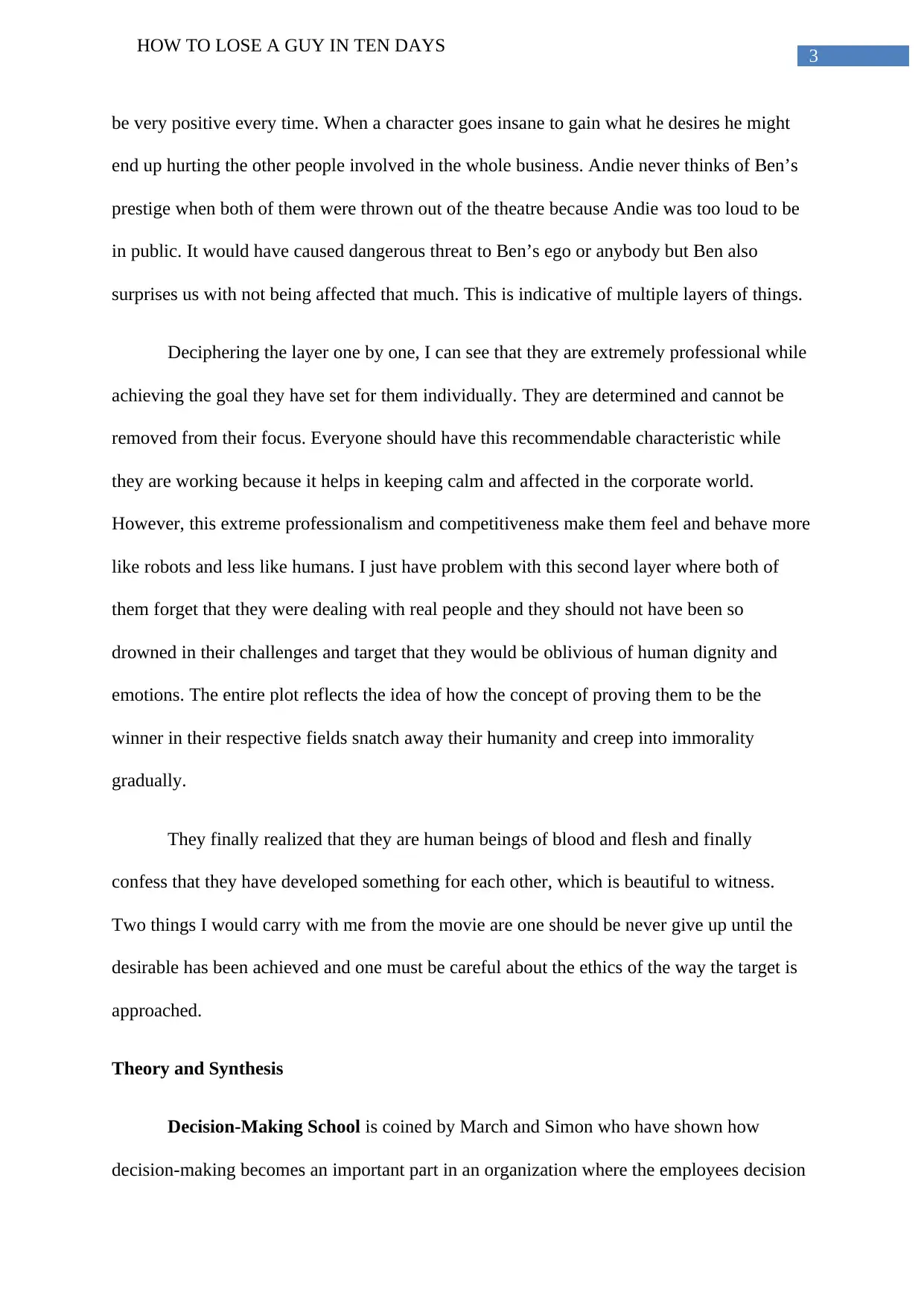
3
HOW TO LOSE A GUY IN TEN DAYS
be very positive every time. When a character goes insane to gain what he desires he might
end up hurting the other people involved in the whole business. Andie never thinks of Ben’s
prestige when both of them were thrown out of the theatre because Andie was too loud to be
in public. It would have caused dangerous threat to Ben’s ego or anybody but Ben also
surprises us with not being affected that much. This is indicative of multiple layers of things.
Deciphering the layer one by one, I can see that they are extremely professional while
achieving the goal they have set for them individually. They are determined and cannot be
removed from their focus. Everyone should have this recommendable characteristic while
they are working because it helps in keeping calm and affected in the corporate world.
However, this extreme professionalism and competitiveness make them feel and behave more
like robots and less like humans. I just have problem with this second layer where both of
them forget that they were dealing with real people and they should not have been so
drowned in their challenges and target that they would be oblivious of human dignity and
emotions. The entire plot reflects the idea of how the concept of proving them to be the
winner in their respective fields snatch away their humanity and creep into immorality
gradually.
They finally realized that they are human beings of blood and flesh and finally
confess that they have developed something for each other, which is beautiful to witness.
Two things I would carry with me from the movie are one should be never give up until the
desirable has been achieved and one must be careful about the ethics of the way the target is
approached.
Theory and Synthesis
Decision-Making School is coined by March and Simon who have shown how
decision-making becomes an important part in an organization where the employees decision
HOW TO LOSE A GUY IN TEN DAYS
be very positive every time. When a character goes insane to gain what he desires he might
end up hurting the other people involved in the whole business. Andie never thinks of Ben’s
prestige when both of them were thrown out of the theatre because Andie was too loud to be
in public. It would have caused dangerous threat to Ben’s ego or anybody but Ben also
surprises us with not being affected that much. This is indicative of multiple layers of things.
Deciphering the layer one by one, I can see that they are extremely professional while
achieving the goal they have set for them individually. They are determined and cannot be
removed from their focus. Everyone should have this recommendable characteristic while
they are working because it helps in keeping calm and affected in the corporate world.
However, this extreme professionalism and competitiveness make them feel and behave more
like robots and less like humans. I just have problem with this second layer where both of
them forget that they were dealing with real people and they should not have been so
drowned in their challenges and target that they would be oblivious of human dignity and
emotions. The entire plot reflects the idea of how the concept of proving them to be the
winner in their respective fields snatch away their humanity and creep into immorality
gradually.
They finally realized that they are human beings of blood and flesh and finally
confess that they have developed something for each other, which is beautiful to witness.
Two things I would carry with me from the movie are one should be never give up until the
desirable has been achieved and one must be careful about the ethics of the way the target is
approached.
Theory and Synthesis
Decision-Making School is coined by March and Simon who have shown how
decision-making becomes an important part in an organization where the employees decision
Paraphrase This Document
Need a fresh take? Get an instant paraphrase of this document with our AI Paraphraser
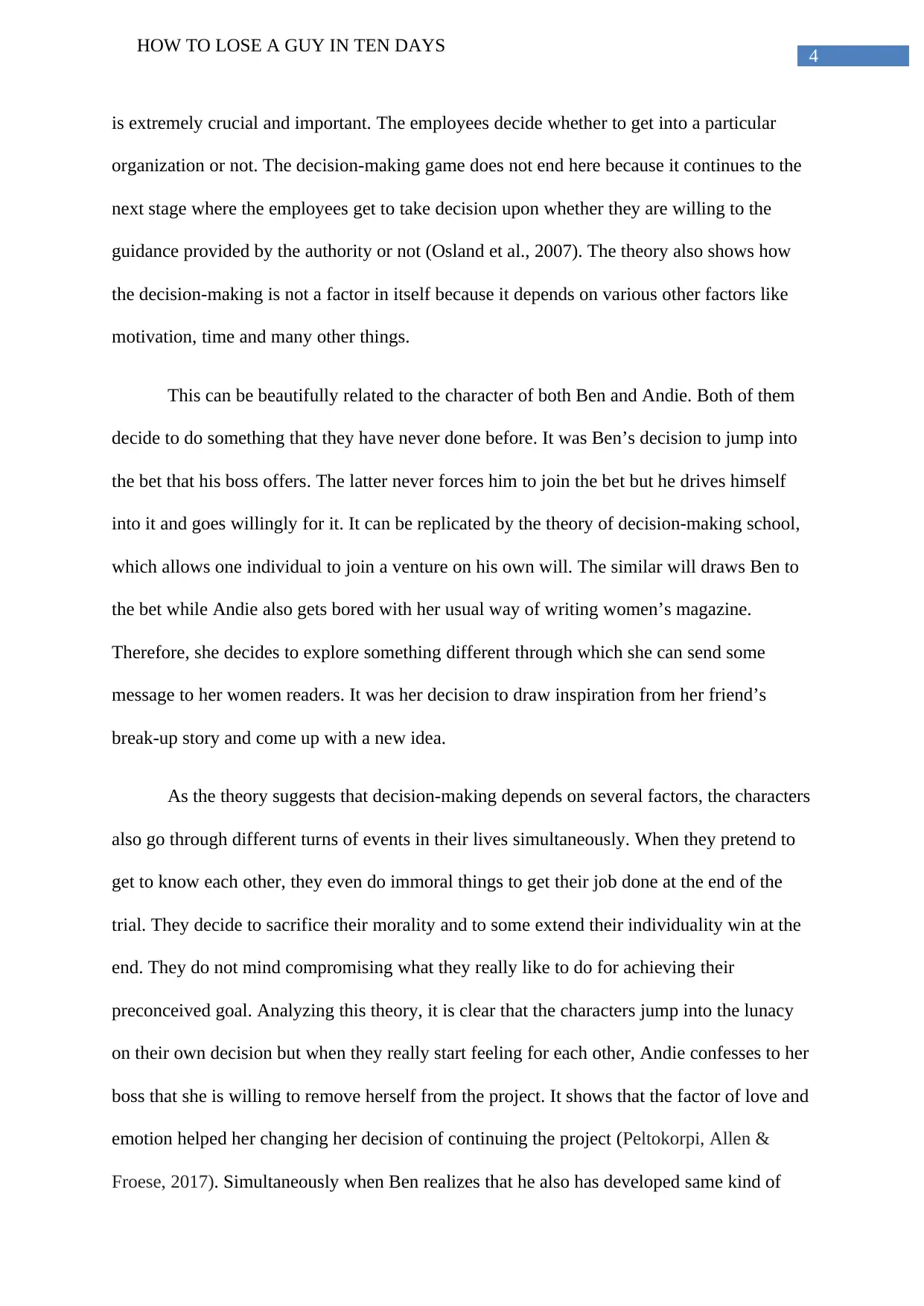
4
HOW TO LOSE A GUY IN TEN DAYS
is extremely crucial and important. The employees decide whether to get into a particular
organization or not. The decision-making game does not end here because it continues to the
next stage where the employees get to take decision upon whether they are willing to the
guidance provided by the authority or not (Osland et al., 2007). The theory also shows how
the decision-making is not a factor in itself because it depends on various other factors like
motivation, time and many other things.
This can be beautifully related to the character of both Ben and Andie. Both of them
decide to do something that they have never done before. It was Ben’s decision to jump into
the bet that his boss offers. The latter never forces him to join the bet but he drives himself
into it and goes willingly for it. It can be replicated by the theory of decision-making school,
which allows one individual to join a venture on his own will. The similar will draws Ben to
the bet while Andie also gets bored with her usual way of writing women’s magazine.
Therefore, she decides to explore something different through which she can send some
message to her women readers. It was her decision to draw inspiration from her friend’s
break-up story and come up with a new idea.
As the theory suggests that decision-making depends on several factors, the characters
also go through different turns of events in their lives simultaneously. When they pretend to
get to know each other, they even do immoral things to get their job done at the end of the
trial. They decide to sacrifice their morality and to some extend their individuality win at the
end. They do not mind compromising what they really like to do for achieving their
preconceived goal. Analyzing this theory, it is clear that the characters jump into the lunacy
on their own decision but when they really start feeling for each other, Andie confesses to her
boss that she is willing to remove herself from the project. It shows that the factor of love and
emotion helped her changing her decision of continuing the project (Peltokorpi, Allen &
Froese, 2017). Simultaneously when Ben realizes that he also has developed same kind of
HOW TO LOSE A GUY IN TEN DAYS
is extremely crucial and important. The employees decide whether to get into a particular
organization or not. The decision-making game does not end here because it continues to the
next stage where the employees get to take decision upon whether they are willing to the
guidance provided by the authority or not (Osland et al., 2007). The theory also shows how
the decision-making is not a factor in itself because it depends on various other factors like
motivation, time and many other things.
This can be beautifully related to the character of both Ben and Andie. Both of them
decide to do something that they have never done before. It was Ben’s decision to jump into
the bet that his boss offers. The latter never forces him to join the bet but he drives himself
into it and goes willingly for it. It can be replicated by the theory of decision-making school,
which allows one individual to join a venture on his own will. The similar will draws Ben to
the bet while Andie also gets bored with her usual way of writing women’s magazine.
Therefore, she decides to explore something different through which she can send some
message to her women readers. It was her decision to draw inspiration from her friend’s
break-up story and come up with a new idea.
As the theory suggests that decision-making depends on several factors, the characters
also go through different turns of events in their lives simultaneously. When they pretend to
get to know each other, they even do immoral things to get their job done at the end of the
trial. They decide to sacrifice their morality and to some extend their individuality win at the
end. They do not mind compromising what they really like to do for achieving their
preconceived goal. Analyzing this theory, it is clear that the characters jump into the lunacy
on their own decision but when they really start feeling for each other, Andie confesses to her
boss that she is willing to remove herself from the project. It shows that the factor of love and
emotion helped her changing her decision of continuing the project (Peltokorpi, Allen &
Froese, 2017). Simultaneously when Ben realizes that he also has developed same kind of
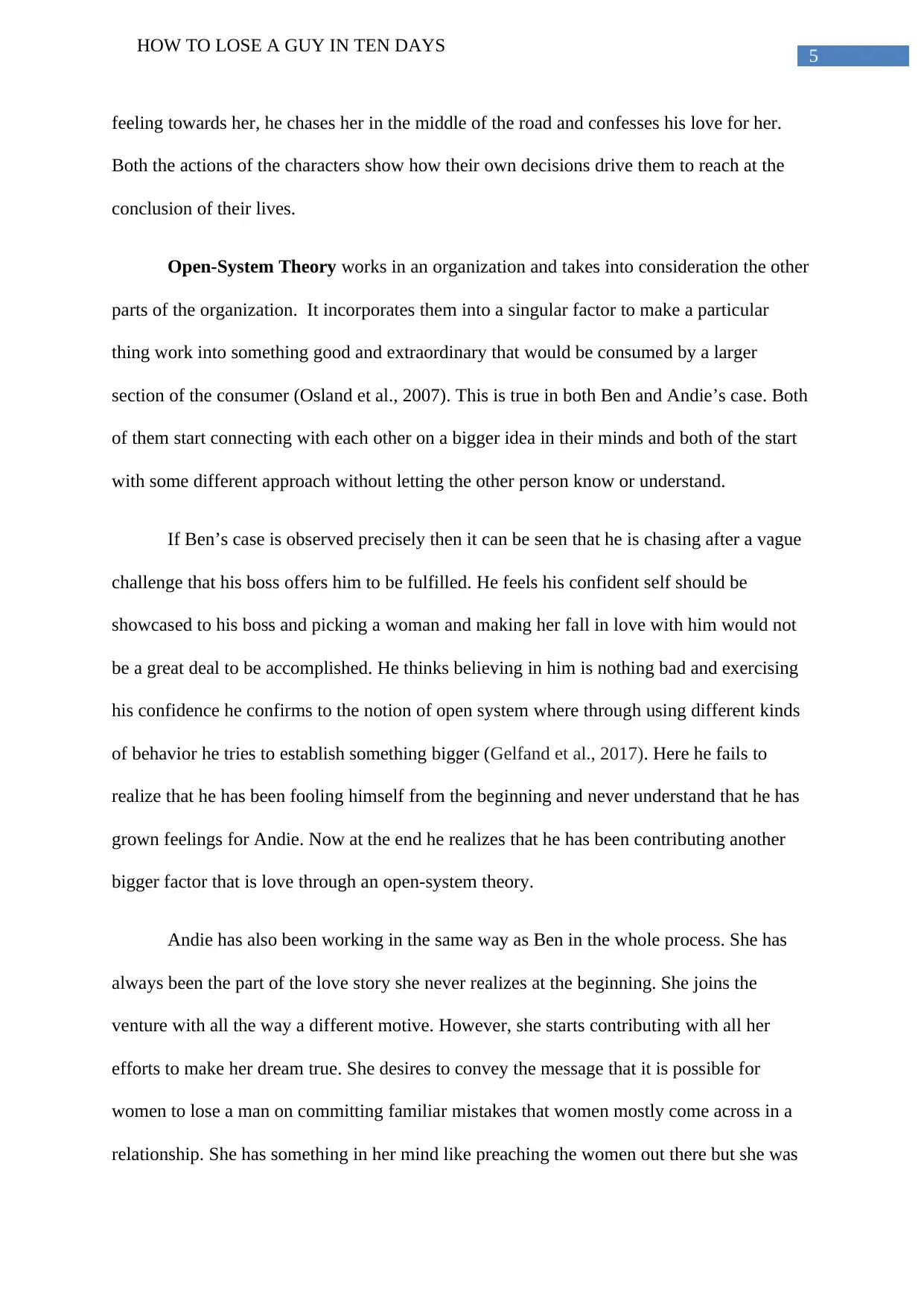
5
HOW TO LOSE A GUY IN TEN DAYS
feeling towards her, he chases her in the middle of the road and confesses his love for her.
Both the actions of the characters show how their own decisions drive them to reach at the
conclusion of their lives.
Open-System Theory works in an organization and takes into consideration the other
parts of the organization. It incorporates them into a singular factor to make a particular
thing work into something good and extraordinary that would be consumed by a larger
section of the consumer (Osland et al., 2007). This is true in both Ben and Andie’s case. Both
of them start connecting with each other on a bigger idea in their minds and both of the start
with some different approach without letting the other person know or understand.
If Ben’s case is observed precisely then it can be seen that he is chasing after a vague
challenge that his boss offers him to be fulfilled. He feels his confident self should be
showcased to his boss and picking a woman and making her fall in love with him would not
be a great deal to be accomplished. He thinks believing in him is nothing bad and exercising
his confidence he confirms to the notion of open system where through using different kinds
of behavior he tries to establish something bigger (Gelfand et al., 2017). Here he fails to
realize that he has been fooling himself from the beginning and never understand that he has
grown feelings for Andie. Now at the end he realizes that he has been contributing another
bigger factor that is love through an open-system theory.
Andie has also been working in the same way as Ben in the whole process. She has
always been the part of the love story she never realizes at the beginning. She joins the
venture with all the way a different motive. However, she starts contributing with all her
efforts to make her dream true. She desires to convey the message that it is possible for
women to lose a man on committing familiar mistakes that women mostly come across in a
relationship. She has something in her mind like preaching the women out there but she was
HOW TO LOSE A GUY IN TEN DAYS
feeling towards her, he chases her in the middle of the road and confesses his love for her.
Both the actions of the characters show how their own decisions drive them to reach at the
conclusion of their lives.
Open-System Theory works in an organization and takes into consideration the other
parts of the organization. It incorporates them into a singular factor to make a particular
thing work into something good and extraordinary that would be consumed by a larger
section of the consumer (Osland et al., 2007). This is true in both Ben and Andie’s case. Both
of them start connecting with each other on a bigger idea in their minds and both of the start
with some different approach without letting the other person know or understand.
If Ben’s case is observed precisely then it can be seen that he is chasing after a vague
challenge that his boss offers him to be fulfilled. He feels his confident self should be
showcased to his boss and picking a woman and making her fall in love with him would not
be a great deal to be accomplished. He thinks believing in him is nothing bad and exercising
his confidence he confirms to the notion of open system where through using different kinds
of behavior he tries to establish something bigger (Gelfand et al., 2017). Here he fails to
realize that he has been fooling himself from the beginning and never understand that he has
grown feelings for Andie. Now at the end he realizes that he has been contributing another
bigger factor that is love through an open-system theory.
Andie has also been working in the same way as Ben in the whole process. She has
always been the part of the love story she never realizes at the beginning. She joins the
venture with all the way a different motive. However, she starts contributing with all her
efforts to make her dream true. She desires to convey the message that it is possible for
women to lose a man on committing familiar mistakes that women mostly come across in a
relationship. She has something in her mind like preaching the women out there but she was
⊘ This is a preview!⊘
Do you want full access?
Subscribe today to unlock all pages.

Trusted by 1+ million students worldwide
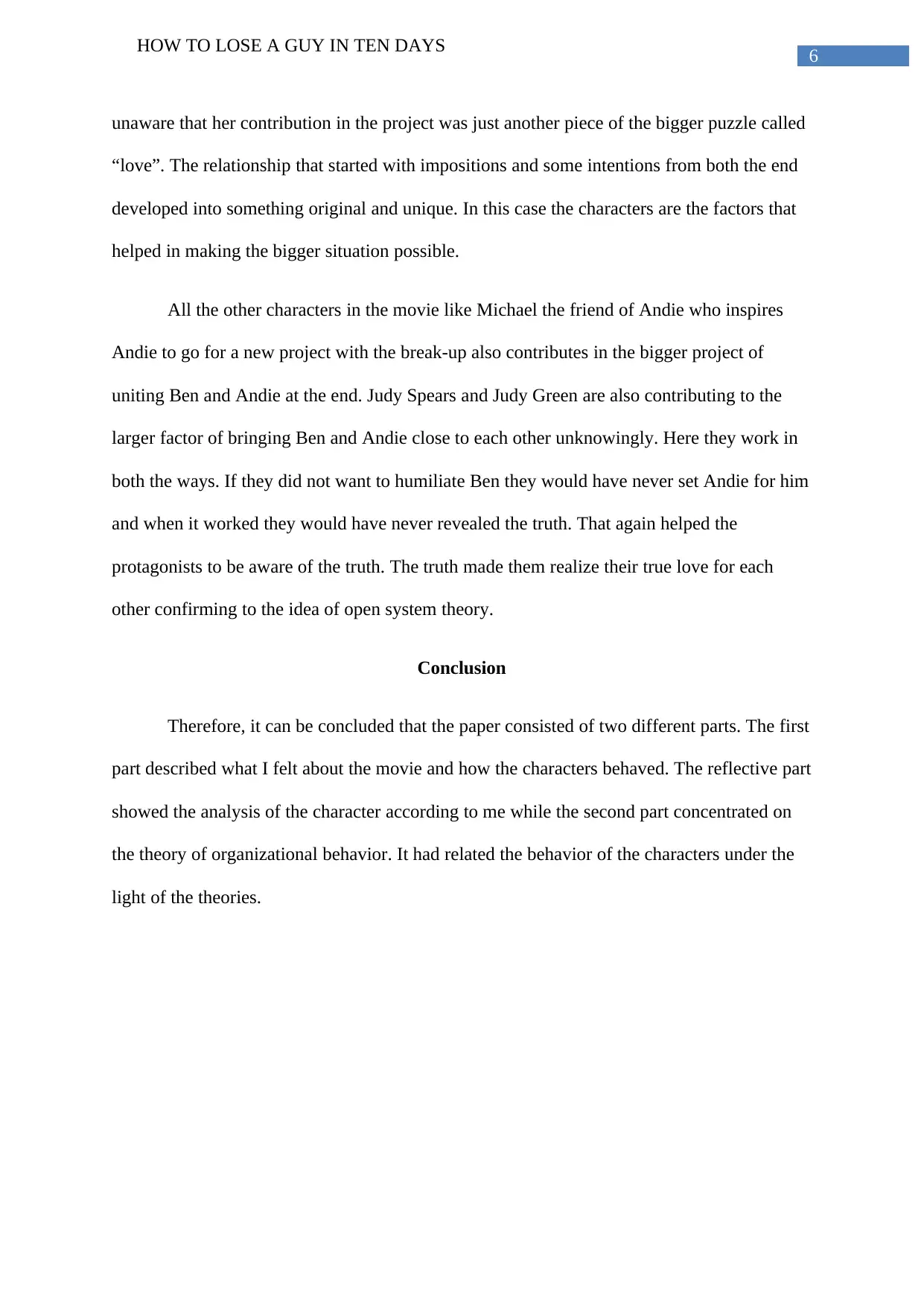
6
HOW TO LOSE A GUY IN TEN DAYS
unaware that her contribution in the project was just another piece of the bigger puzzle called
“love”. The relationship that started with impositions and some intentions from both the end
developed into something original and unique. In this case the characters are the factors that
helped in making the bigger situation possible.
All the other characters in the movie like Michael the friend of Andie who inspires
Andie to go for a new project with the break-up also contributes in the bigger project of
uniting Ben and Andie at the end. Judy Spears and Judy Green are also contributing to the
larger factor of bringing Ben and Andie close to each other unknowingly. Here they work in
both the ways. If they did not want to humiliate Ben they would have never set Andie for him
and when it worked they would have never revealed the truth. That again helped the
protagonists to be aware of the truth. The truth made them realize their true love for each
other confirming to the idea of open system theory.
Conclusion
Therefore, it can be concluded that the paper consisted of two different parts. The first
part described what I felt about the movie and how the characters behaved. The reflective part
showed the analysis of the character according to me while the second part concentrated on
the theory of organizational behavior. It had related the behavior of the characters under the
light of the theories.
HOW TO LOSE A GUY IN TEN DAYS
unaware that her contribution in the project was just another piece of the bigger puzzle called
“love”. The relationship that started with impositions and some intentions from both the end
developed into something original and unique. In this case the characters are the factors that
helped in making the bigger situation possible.
All the other characters in the movie like Michael the friend of Andie who inspires
Andie to go for a new project with the break-up also contributes in the bigger project of
uniting Ben and Andie at the end. Judy Spears and Judy Green are also contributing to the
larger factor of bringing Ben and Andie close to each other unknowingly. Here they work in
both the ways. If they did not want to humiliate Ben they would have never set Andie for him
and when it worked they would have never revealed the truth. That again helped the
protagonists to be aware of the truth. The truth made them realize their true love for each
other confirming to the idea of open system theory.
Conclusion
Therefore, it can be concluded that the paper consisted of two different parts. The first
part described what I felt about the movie and how the characters behaved. The reflective part
showed the analysis of the character according to me while the second part concentrated on
the theory of organizational behavior. It had related the behavior of the characters under the
light of the theories.
Paraphrase This Document
Need a fresh take? Get an instant paraphrase of this document with our AI Paraphraser
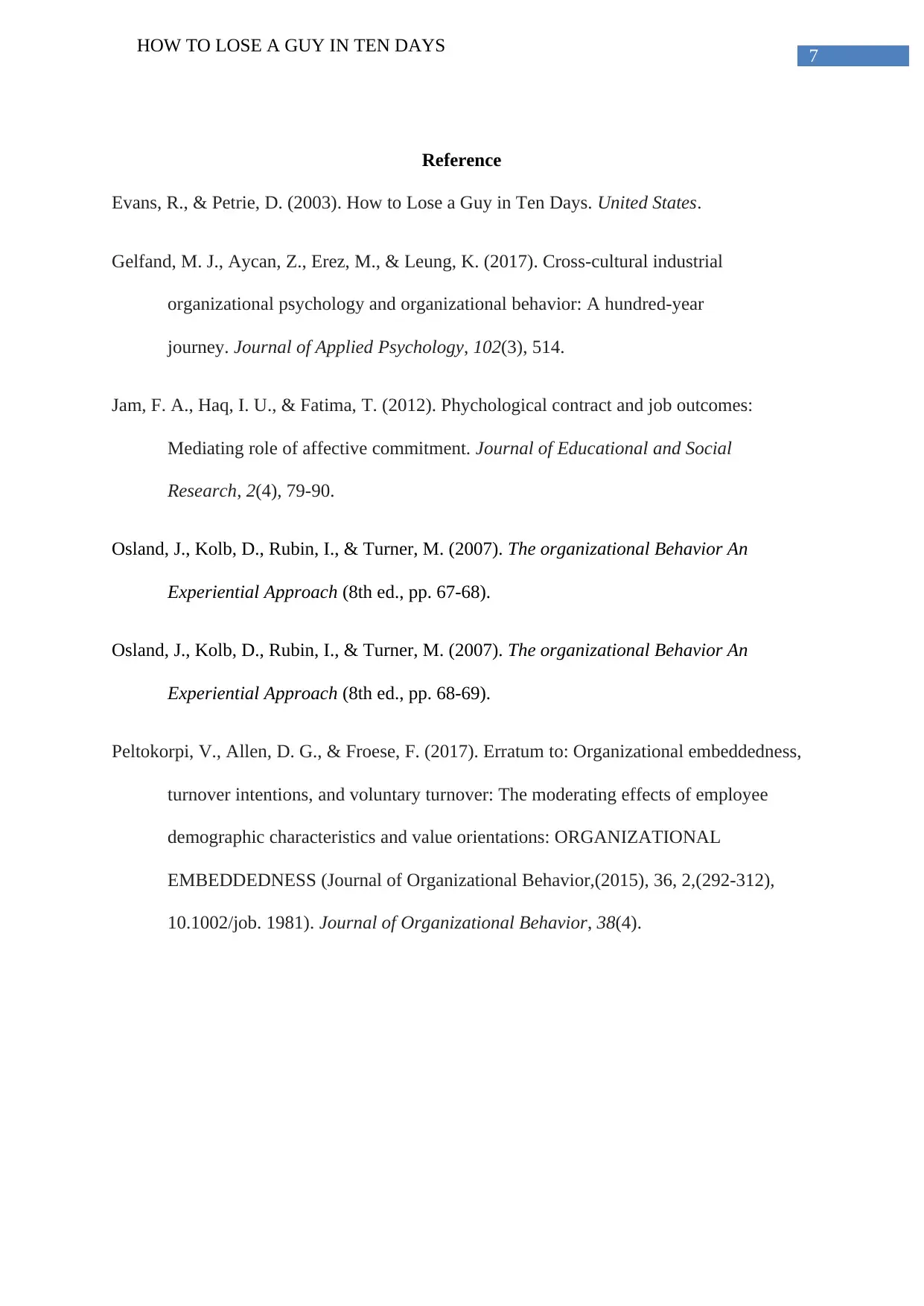
7
HOW TO LOSE A GUY IN TEN DAYS
Reference
Evans, R., & Petrie, D. (2003). How to Lose a Guy in Ten Days. United States.
Gelfand, M. J., Aycan, Z., Erez, M., & Leung, K. (2017). Cross-cultural industrial
organizational psychology and organizational behavior: A hundred-year
journey. Journal of Applied Psychology, 102(3), 514.
Jam, F. A., Haq, I. U., & Fatima, T. (2012). Phychological contract and job outcomes:
Mediating role of affective commitment. Journal of Educational and Social
Research, 2(4), 79-90.
Osland, J., Kolb, D., Rubin, I., & Turner, M. (2007). The organizational Behavior An
Experiential Approach (8th ed., pp. 67-68).
Osland, J., Kolb, D., Rubin, I., & Turner, M. (2007). The organizational Behavior An
Experiential Approach (8th ed., pp. 68-69).
Peltokorpi, V., Allen, D. G., & Froese, F. (2017). Erratum to: Organizational embeddedness,
turnover intentions, and voluntary turnover: The moderating effects of employee
demographic characteristics and value orientations: ORGANIZATIONAL
EMBEDDEDNESS (Journal of Organizational Behavior,(2015), 36, 2,(292-312),
10.1002/job. 1981). Journal of Organizational Behavior, 38(4).
HOW TO LOSE A GUY IN TEN DAYS
Reference
Evans, R., & Petrie, D. (2003). How to Lose a Guy in Ten Days. United States.
Gelfand, M. J., Aycan, Z., Erez, M., & Leung, K. (2017). Cross-cultural industrial
organizational psychology and organizational behavior: A hundred-year
journey. Journal of Applied Psychology, 102(3), 514.
Jam, F. A., Haq, I. U., & Fatima, T. (2012). Phychological contract and job outcomes:
Mediating role of affective commitment. Journal of Educational and Social
Research, 2(4), 79-90.
Osland, J., Kolb, D., Rubin, I., & Turner, M. (2007). The organizational Behavior An
Experiential Approach (8th ed., pp. 67-68).
Osland, J., Kolb, D., Rubin, I., & Turner, M. (2007). The organizational Behavior An
Experiential Approach (8th ed., pp. 68-69).
Peltokorpi, V., Allen, D. G., & Froese, F. (2017). Erratum to: Organizational embeddedness,
turnover intentions, and voluntary turnover: The moderating effects of employee
demographic characteristics and value orientations: ORGANIZATIONAL
EMBEDDEDNESS (Journal of Organizational Behavior,(2015), 36, 2,(292-312),
10.1002/job. 1981). Journal of Organizational Behavior, 38(4).
1 out of 8
Related Documents
Your All-in-One AI-Powered Toolkit for Academic Success.
+13062052269
info@desklib.com
Available 24*7 on WhatsApp / Email
![[object Object]](/_next/static/media/star-bottom.7253800d.svg)
Unlock your academic potential
Copyright © 2020–2025 A2Z Services. All Rights Reserved. Developed and managed by ZUCOL.





